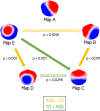Early alterations of large-scale brain networks temporal dynamics in young children with autism
- PMID: 34400754
- PMCID: PMC8367954
- DOI: 10.1038/s42003-021-02494-3
Early alterations of large-scale brain networks temporal dynamics in young children with autism
Abstract
Autism spectrum disorders (ASD) are associated with disruption of large-scale brain network. Recently, we found that directed functional connectivity alterations of social brain networks are a core component of atypical brain development at early developmental stages in ASD. Here, we investigated the spatio-temporal dynamics of whole-brain neuronal networks at a subsecond scale in 113 toddlers and preschoolers (66 with ASD) using an EEG microstate approach. We first determined the predominant microstates using established clustering methods. We identified five predominant microstate (labeled as microstate classes A-E) with significant differences in the temporal dynamics of microstate class B between the groups in terms of increased appearance and prolonged duration. Using Markov chains, we found differences in the dynamic syntax between several maps in toddlers and preschoolers with ASD compared to their TD peers. Finally, exploratory analysis of brain-behavioral relationships within the ASD group suggested that the temporal dynamics of some maps were related to conditions comorbid to ASD during early developmental stages.
© 2021. The Author(s).
Conflict of interest statement
The authors declare no competing interests.
Figures







References
-
- Brothers L. The social brain: a project for integrating primate behavior and neurophysiology in a new domain. Concepts Neurosci. 1990;1:27–61.

